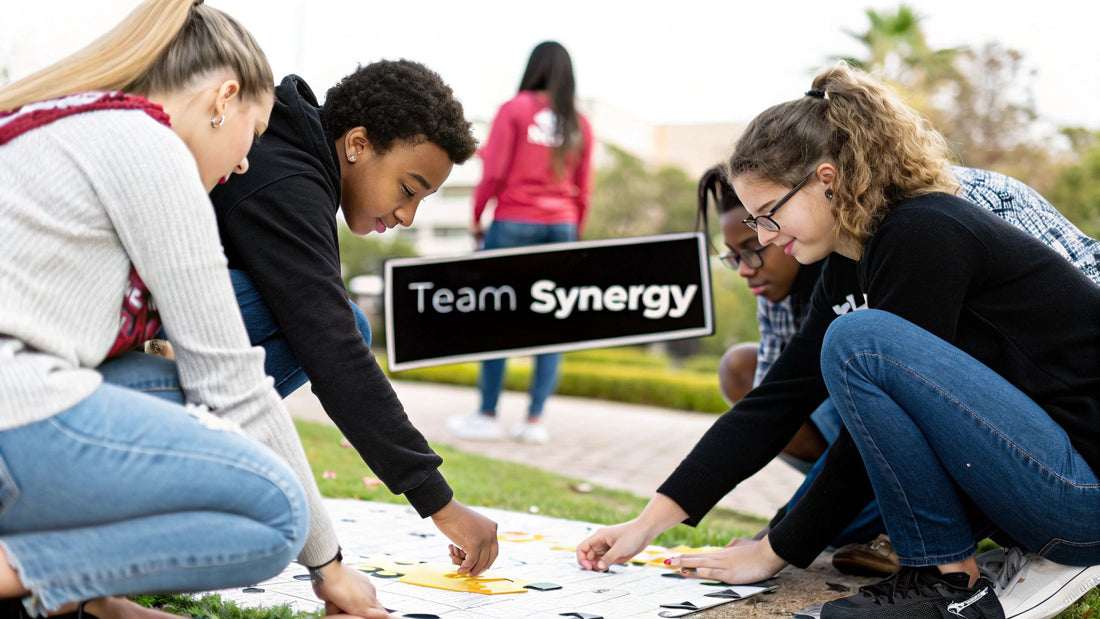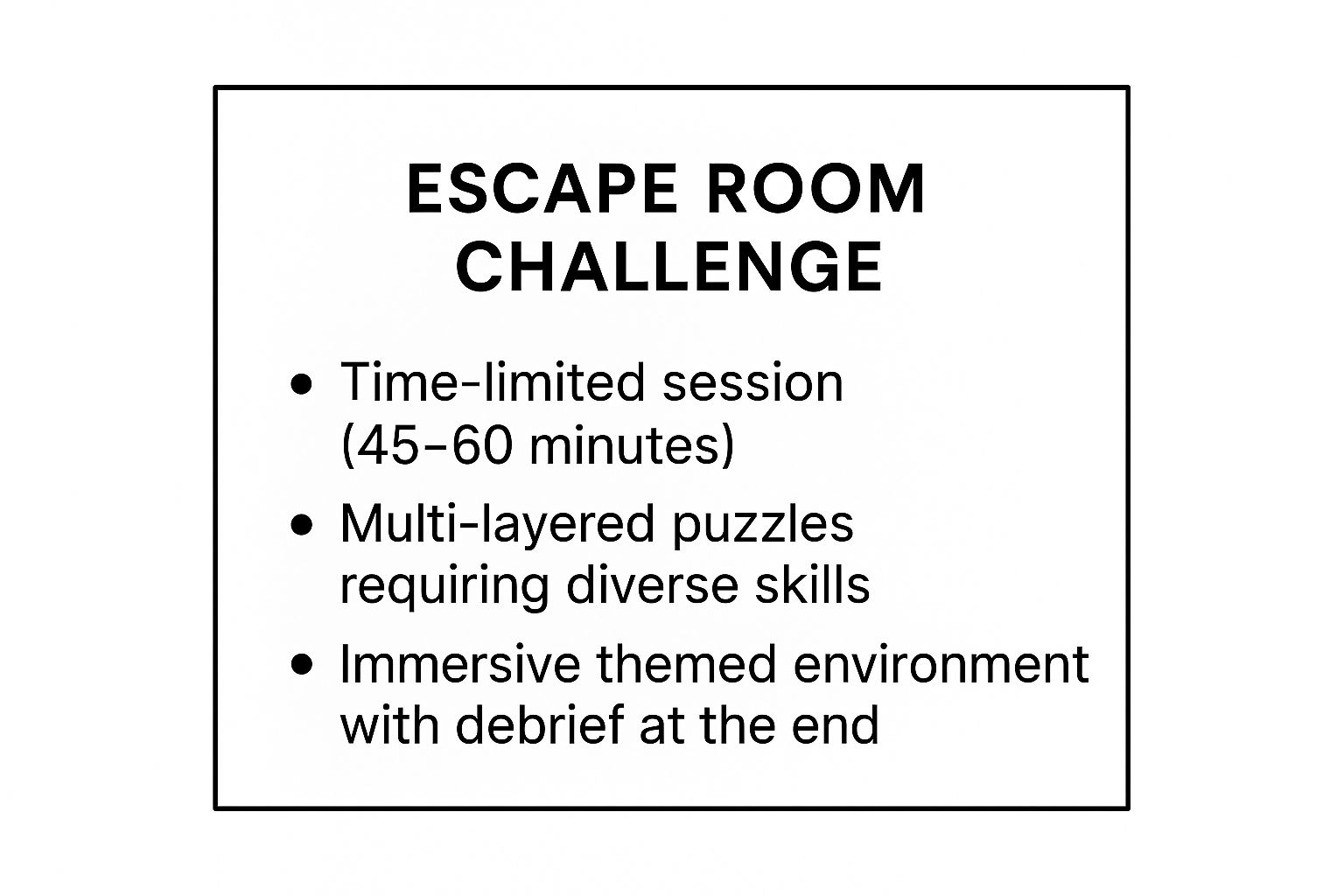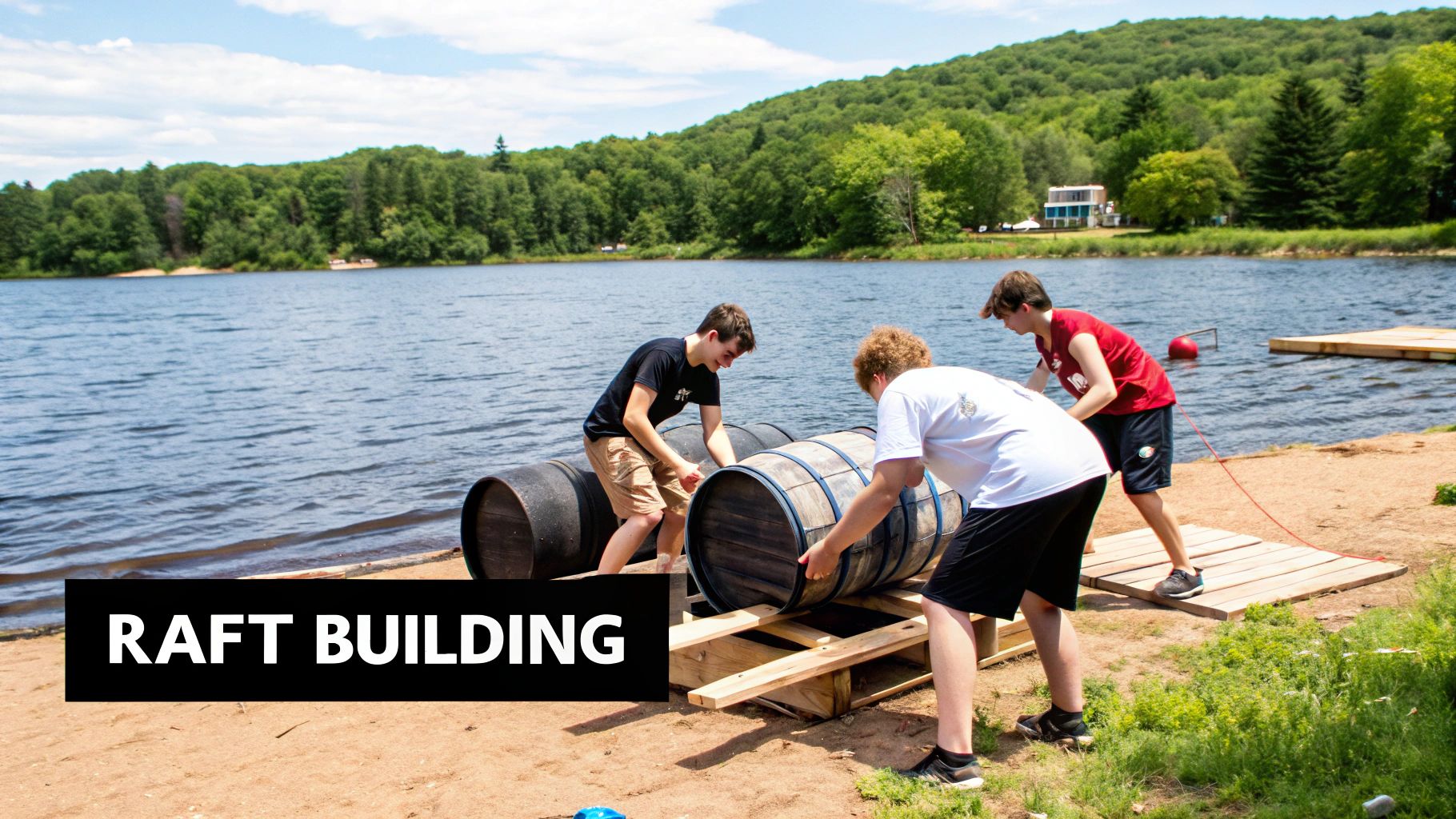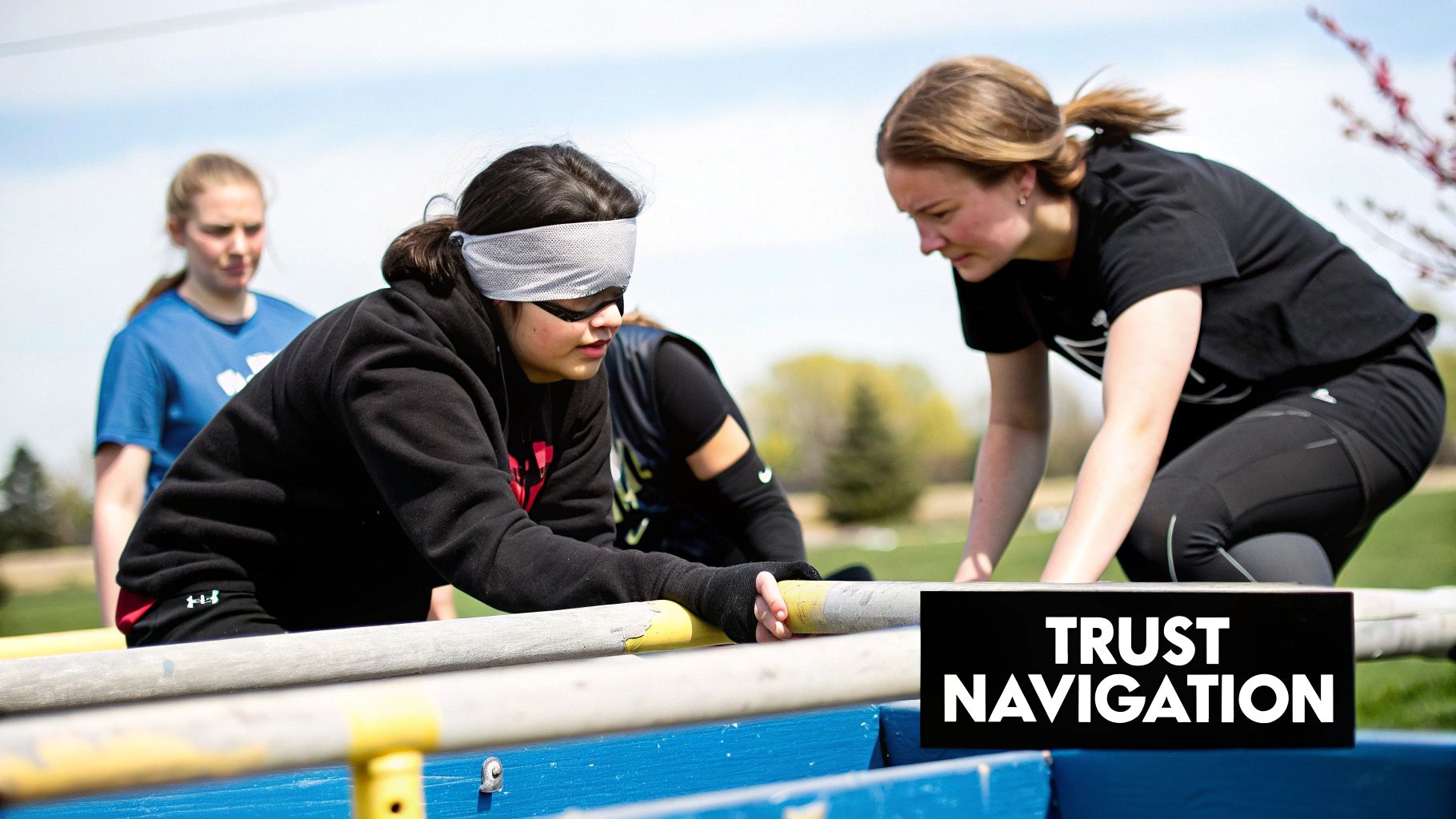
9 Top Team Building Activities for Youth Wellbeing in 2025
Share
In the UK, the conversation around children's mental health is more urgent than ever. Recent statistics reveal a concerning rise in anxiety and depression among young people, often amplified by the pressures of social media and academic expectations. According to the NHS, one in five children and young people in England aged 8 to 25 had a probable mental health condition in 2023. This isn't just a statistic; it represents individuals navigating immense challenges. The cost to businesses from poor mental health in the workforce, estimated to be up to £56 billion annually for UK employers, is a stark reminder of the long-term impact, underscoring the importance of addressing mental health from a young age.
Thoughtfully organised team building activities for youth are a powerful, practical tool in this effort. They move beyond simple fun, offering a structured environment to develop crucial life skills: communication, problem-solving, empathy, and self-awareness. These activities also provide a space for developing leadership skills, which is a crucial component of fostering healthy teamwork, allowing every child to contribute positively. In fact, an effective approach involves nurturing team leadership qualities in young individuals regardless of their natural confidence levels.
In this comprehensive guide, we'll explore nine diverse activities designed not only to foster teamwork but also to support the emotional wellbeing of young people, providing a solid foundation for their mental health. Each entry includes objectives, step-by-step instructions, and vital tie-ins to emotional wellness.
Disclaimer: I am not a mental health professional. The information provided is for educational purposes. If you have concerns about a child's mental health, please consult a GP or a qualified mental health specialist.
1. The Escape Room Challenge: Collaborative Problem-Solving Under Pressure
An Escape Room is a high-energy, collaborative activity where a team is "locked" in a themed room and must solve a series of puzzles and riddles to "escape" within a set time limit, typically 45-60 minutes. This popular team-building activity for youth excels at creating a memorable and immersive experience that demands communication, critical thinking, and grace under pressure. It's a powerful tool for observing team dynamics in action.
More than just a game, the escape room mirrors real-world scenarios where quick, collaborative decisions are necessary. For young people, particularly with rising rates of anxiety, this provides a safe, controlled environment to practise managing stress and working towards a common goal. For example, a team might face a time-sensitive puzzle that triggers feelings of panic; success hinges on them using calming techniques, listening to each other, and breaking the problem down into smaller, manageable steps, a practical skill for managing anxiety.
Practical Implementation
Many organisations use this method effectively. Summer camps at YMCA locations nationwide often incorporate escape rooms to help new groups bond quickly. Similarly, school leadership programmes utilise portable kits to create custom challenges focused on specific learning objectives. For example, a school in Manchester created a history-themed escape room where pupils had to solve clues related to their curriculum, reinforcing learning while building teamwork.
For a quick reference on the core components of this activity, see the summary below.

This structure ensures a focused, engaging, and reflective experience that maximises learning and teamwork. The post-activity debrief is crucial; it transforms the game into a potent lesson by allowing participants to discuss what worked, what didn't, and how they can improve their collaborative skills in the future.
2. Human Knot Challenge: Fostering Communication and Physical Problem-Solving
The Human Knot Challenge is a classic, hands-on activity that requires a group to untangle themselves from a "knot" created by linking hands. Participants stand in a circle, reach across to grab the hands of two different people, and then must communicate and cooperate to unravel the tangle into a single circle without letting go. This exercise is an excellent physical metaphor for navigating complex problems and is one of the most effective team building activities for youth when it comes to illustrating interdependence.
This challenge powerfully demonstrates the need for clear communication, patience, and leadership. As participants twist and turn, they learn to voice suggestions, listen to others' perspectives, and move as a cohesive unit. For young people, it provides a tangible experience of how individual actions affect the entire group. In a world where the curated perfection of social media can heighten feelings of inadequacy, this physical problem-solving task reinforces the value of teamwork and shared physical space, promoting a sense of collective achievement.
Practical Implementation
The Human Knot is a staple in programmes designed to build group cohesion quickly. For instance, a youth group in Bristol used this as an icebreaker for a mental health workshop, helping to physically demonstrate how problems can feel tangled but can be solved with cooperation. It's also frequently used during university freshers' weeks and in YMCA day camps to break the ice and encourage new acquaintances to work together. Its simplicity means it can be run almost anywhere, from a school hall to a park.
To get the most out of this exercise, it's vital to guide the group through a post-activity reflection. Discussing what communication strategies worked, where frustrations arose, and how they overcame obstacles is key. This transforms a fun physical puzzle into a lasting lesson on collaboration and resilience. For more ideas on fostering well-being, you can find a range of kids' mental health activities that complement this exercise.
3. Raft Building Competition: Engineering Teamwork and Resilience
The Raft Building Competition is a classic hands-on challenge where teams are given identical, limited materials—such as barrels, ropes, and planks—and tasked with designing and constructing a functional raft. The activity culminates in a race or float test on water, making it an exhilarating test of planning, collaboration, and practical problem-solving. This is one of the most effective team building activities for youth as it combines physical activity with strategic thinking.

More than just building a float, this exercise builds trust and resilience. It forces participants to communicate clearly, assign roles based on strengths, and adapt their plans when things inevitably go wrong. The pervasive influence of social media often creates a fear of failure; this activity normalises it. A raft that sinks is not a failure but a learning opportunity, teaching young people to embrace trial and error and support each other through setbacks.
Practical Implementation
This activity has been a cornerstone of programmes designed to foster leadership and cooperation. For example, The Scout Association regularly uses raft building in its jamborees to teach basic engineering principles alongside crucial interpersonal skills. Similarly, many school outdoor education centres, like those in the Lake District, incorporate it into their curricula to build resilience and teamwork. The key is ensuring a safe environment with strict supervision.
The competition element adds excitement, but the real victory lies in the collaborative journey. A post-activity discussion is vital for helping participants connect the experience to real-life challenges, exploring how they managed disagreements, allocated tasks, and supported each other under pressure. This reflection turns a fun afternoon into a lasting lesson in teamwork and perseverance.
4. Improv Theatre Games: Building Confidence Through Spontaneity
Improv theatre games are a series of dynamic, unscripted exercises where young people must listen intently, build on each other's ideas, and collaboratively create scenes on the spot. Rooted in the core principle of "Yes, And," these activities challenge participants to accept what a partner offers and add to it, fostering an environment of acceptance, creativity, and mutual support. This makes it one of the most effective team building activities for youth who may struggle with social anxiety or fear of judgement.
More than just a performance art, improv teaches essential life skills. For young people navigating the constant comparison culture of social media, it offers a space to practise adaptability and embrace imperfection. Success isn't about being the funniest person in the room; it’s about active listening and making your scene partner look good. This shifts the focus from individual achievement to collective success, building trust and psychological safety within the group.
Practical Implementation
The power of improv is recognised far beyond the stage. For instance, many community arts centres across the UK run youth improv workshops specifically aimed at building confidence. Similarly, some NHS child and adolescent mental health services (CAMHS) incorporate improv exercises to help young patients express themselves and connect with others in a low-pressure, fun way. The key is creating a supportive atmosphere where mistakes are celebrated as opportunities for creativity.
For a quick reference on the core components of this activity, see the summary below.
This structure ensures participants feel safe to experiment and be vulnerable. The most crucial element is a post-activity debrief, where the group can reflect on how it felt to build something together spontaneously. This discussion helps participants connect the experience to real-world collaboration, reinforcing how skills like active listening and supporting others' ideas are vital in all aspects of life.
5. Amazing Race Challenge: Strategic Navigation and Diverse Skills
An Amazing Race Challenge is a large-scale, multi-station adventure where teams navigate across different locations to complete a series of physical, mental, and creative tasks. Inspired by the popular television show, this activity pushes teams to manage time, think strategically, and leverage the diverse skills of each member. It is an exceptional team-building activity for youth that fosters resilience, adaptability, and complex problem-solving in a dynamic environment.
This challenge is more than a simple scavenger hunt; it’s a microcosm of managing a large project with multiple deadlines. For young people navigating the pressures of school and social life, this provides a practical, hands-on experience in planning, executing, and adapting under pressure. For example, a team might get lost or struggle with a puzzle; their ability to manage frustration, communicate calmly, and pivot their strategy without blaming each other is a direct exercise in emotional regulation.
Practical Implementation
This format is highly adaptable and used by various organisations. University freshers' weeks often use campus-wide Amazing Race challenges to familiarise new students with the layout and build peer connections. Likewise, community youth groups organise them as engaging fundraising events, encouraging teamwork while serving a greater cause. A practical example is a local council in London that organised a race between youth centres, with clues hidden in local landmarks to promote community engagement.
For a deeper look into a variety of engaging group activities, explore these team-building activities for children to find more inspiration for your group.
This structure promotes a high-energy, memorable experience that strengthens bonds and reveals natural leadership qualities. The post-event debrief is essential for reflection, allowing participants to discuss their team's strategic decisions, communication breakdowns, and moments of triumph, translating the fun into lasting lessons on collaboration.
6. Trust Fall Progression: Building Foundational Trust and Vulnerability
The Trust Fall Progression is a structured sequence of activities designed to methodically build trust among team members, culminating in the classic trust fall. It begins with low-risk partner exercises, like leading a blindfolded peer (a trust walk), and gradually increases the perceived risk, teaching participants both how to rely on others and how to be reliable. This progression is a powerful metaphor for creating psychological safety within a group.
This activity directly addresses core elements of emotional wellbeing, such as managing vulnerability and building secure attachments. In an era where the superficial nature of social media can create a facade of connection, learning to place tangible trust in others is a vital skill. For young people navigating social anxieties, this provides a physical, real-world context to practise interdependence, communication, and mutual respect. Success is not just about catching someone; it’s about creating an environment where every member feels secure enough to be vulnerable.
Practical Implementation
This method is a cornerstone of experiential education and leadership development. Organisations like the Outward Bound Trust have popularised these progressions in their wilderness courses to forge deep bonds within groups facing shared challenges. A practical example would be a school using a simple trust walk on the playing field before progressing to more involved activities in the gym hall, ensuring pupils feel comfortable at each stage.
To implement this safely, a trained facilitator is essential. They must ensure clear safety guidelines are established, proper spotting techniques are taught, and, crucially, that any participant can opt out without judgement. The progression’s power lies not in forcing participation but in fostering an environment where trust can be built voluntarily. The post-activity debrief is where the real learning is solidified, linking the physical act of trust to interpersonal relationships and teamwork dynamics.
7. Collaborative Art Creation: Fostering a Shared Vision
Collaborative Art Creation is a dynamic activity where a team works together to produce a single, large-scale piece of artwork, such as a mural, sculpture, or digital installation. This process challenges young people to merge their individual ideas into a cohesive, shared vision, fostering communication, compromise, and collective ownership. It's a fantastic method for encouraging creative expression while building essential teamwork skills.
This activity serves as a powerful metaphor for project-based work, where diverse skills and perspectives must align to achieve a common objective. For young people navigating the pressures of school and social life, engaging in a creative, low-stakes project can be a therapeutic outlet. For instance, a group might decide to create a mural based on the theme of 'wellbeing', allowing each member to express what that concept means to them and then negotiate how to blend their ideas into a single, unified piece.
Practical Implementation
This method is highly adaptable and used across various settings. For instance, community youth programmes often organise neighbourhood mural projects to instil a sense of local pride and connection. A powerful example is the "art for wellbeing" workshops where young people collaborate on a piece that is later displayed in a local GP surgery or community centre, giving them a tangible sense of purpose and contribution.
By assigning roles such as a project manager, materials coordinator, and lead artists, you can introduce young people to real-world project dynamics. The final piece stands as a visual testament to their successful collaboration. This approach also ties into developing emotional literacy, as participants learn to articulate their creative ideas and respond constructively to the input of others. You can explore further ways to enhance these skills with additional emotional literacy activities.
8. Blindfold Obstacle Navigation: Building Trust Through Guided Communication
Blindfold Obstacle Navigation is a powerful and engaging exercise where one blindfolded participant navigates a simple obstacle course guided solely by the verbal instructions of their teammates. This activity strips communication down to its most essential elements: clarity, trust, and active listening. It’s a profound exercise for youth, creating a tangible experience of interdependence and shared responsibility within a controlled, safe environment.
The activity serves as a powerful metaphor for navigating life's challenges with support from others. For young people learning to build healthy relationships, it physically demonstrates the importance of giving and receiving guidance. The constant exposure to social media can lead to misinterpretation and anxiety; this exercise forces participants to be precise with their words and rely on the trustworthiness of their peers, directly enhancing skills that are vital for mental wellbeing.

Practical Implementation
This activity is a cornerstone of experiential learning programmes and is frequently used in school peer leadership courses to foster group cohesion. For example, a sports coach might use this to improve on-pitch communication, with players guiding a blindfolded teammate with a ball. The setup is simple, requiring only soft obstacles like cushions, cones, or jumpers, and blindfolds (or sleep shades for comfort), making it one of the most accessible team building activities for youth.
Success is less about completing the course quickly and more about the quality of the communication and the trust that is built. The debrief afterwards is vital; teams should discuss what made instructions effective, how it felt to place their trust in others, and how they can apply these lessons to future group projects. It’s an exercise that builds confidence, empathy, and a deeper understanding of effective teamwork.
9. Group Juggle Evolution: Mastering Complexity and System Thinking
Group Juggle Evolution is a dynamic and deceptively simple activity that builds from a basic ball-tossing exercise into a complex, multi-layered challenge. A group stands in a circle and establishes a throwing pattern with one ball. As they master the pattern, more balls and new rules are introduced, forcing the team to adapt, communicate, and develop a robust system to manage the increasing complexity. This activity is a fantastic, hands-on metaphor for handling growing responsibilities and interconnected tasks.
More than a simple ice-breaker, this activity is an excellent tool for developing systems thinking. It mirrors how real-life projects and team roles evolve, requiring constant adjustment and clear communication to prevent everything from falling apart. For young people dealing with academic pressures, it provides a safe space to practise managing multiple tasks (the balls) and supporting each other when one is 'dropped', fostering a blame-free approach to problem-solving.
Practical Implementation
This activity is a staple in diverse settings due to its adaptability. Youth leadership conferences often use it as a warm-up to introduce concepts of process improvement. A practical example is a teacher using this with a class before a big group project, helping them physically experience the need for clear roles and communication before they start their academic work. The key is to start simple and empower the group to devise their own solutions as the difficulty increases.
The evolution from one ball to many challenges a team's ability to stay focused and support one another, skills crucial for mental resilience. As the pressure mounts, participants learn to manage stress and communicate needs clearly ("Heads up, another one is coming!"). This transforms a fun game into a powerful lesson in adapting to change and maintaining group cohesion under pressure.
Team Building Activities: 9-Item Comparison
| Activity | Implementation Complexity 🔄 | Resource Requirements ⚡ | Expected Outcomes 📊 | Ideal Use Cases 💡 | Key Advantages ⭐ |
|---|---|---|---|---|---|
| Escape Room Challenge | Medium to High (themed setup, booking) | Moderate to High (space, props, booking) | Enhanced teamwork, leadership, creative problem-solving | Youth leadership, corporate youth programmes, camps | High engagement, reveals leadership, immersive and focused |
| Human Knot Challenge | Low (minimal setup) | Minimal (no equipment) | Improved communication, patience, physical cooperation | Ice-breaker, quick team building | Free, easy to set up, encourages cooperation and patience |
| Raft Building Competition | High (materials, safety, supervision) | High (materials, water access, safety gear) | Practical problem-solving, STEM skills, collaboration | Outdoor education, camps, scouting, retreats | Memorable experience, clear success criteria, hands-on STEM |
| Improv Theatre Games | Low to Medium (facilitation skills) | Minimal (space, facilitators) | Creativity, quick thinking, communication confidence | Drama therapy, leadership training, schools | Builds confidence, flexibility, active listening, low cost |
| Amazing Race Challenge | High (multi-location logistics) | High (staff, multiple stations, transport) | Strategic thinking, time management, collaboration | Large group events, retreats, orientation | Exciting, inclusive of various skills, promotes competition |
| Trust Fall Progression | Medium (requires safety and training) | Low to Medium (spotting, space) | Deep trust, confidence, group cohesion | High-trust groups, leadership, therapeutic | Builds strong bonds, emotional growth, adaptable levels |
| Collaborative Art Creation | Medium (materials, planning) | Moderate (art supplies, space) | Creative collaboration, compromise, lasting results | Community programmes, camps, corporate retreats | Inclusive, produces tangible outcomes, low physical demand |
| Blindfold Obstacle Navigation | Medium (safety, setup) | Low to Moderate (obstacles, blindfolds) | Enhanced communication precision, trust, active listening | Trust-building, leadership, therapeutic | Dramatic communication improvement, low cost, adaptable |
| Group Juggle Evolution | Low to Medium (progressive complexity) | Minimal (balls, space) | Focus, coordination, group rhythm | Warm-ups, ice-breakers, process improvement | Develops focus and coordination, immediate feedback |
Continuing the Journey: Resources for Emotional Wellbeing
As we've explored, team building activities for youth are far more than just ways to pass the time. They are powerful, practical exercises in developing emotional fitness. The skills cultivated, from communication to resilience, are vital for navigating the complexities of modern life. The importance of addressing mental health cannot be overstated; it is the foundation upon which young people build happy, successful lives. Ignoring early signs of struggle can lead to long-term difficulties, affecting everything from academic achievement to future career prospects.
The journey, however, doesn't end when the activity is over. The true value lies in integrating these lessons into daily life. This is particularly crucial given the rising challenges young people face, from the constant connectivity of social media to academic stress. As stated earlier, with one in five children and young people experiencing a probable mental health condition, the need for proactive, ongoing support is undeniable.
Actionable Next Steps for Lasting Impact
To build on the momentum gained from these activities, consider these continuous strategies:
- Foster Open Dialogue: Make conversations about feelings and mental health a normal part of your routine. Ask open-ended questions like, "How did that challenge make you feel?" Normalising these discussions reduces stigma.
- Model Healthy Coping: Demonstrate healthy ways to manage stress. Whether it's taking a walk, practising deep breathing, or talking through a problem, your actions provide a powerful blueprint.
- Integrate Mindfulness & Relaxation: Introduce simple relaxation tips. A five-minute guided meditation, a quiet moment for journaling, or simple breathing exercises (like box breathing: inhale for four, hold for four, exhale for four, hold for four) can be incredibly effective tools for managing anxiety.
- Explore Further Resources: Expand your toolkit. You can explore a variety of engaging group games, discover mental health-focused books that open up conversations, or even find mental health apparel with positive slogans that act as gentle, affirming reminders.
Valuing Mental Wellness
Prioritising youth mental health has benefits that extend far beyond individual happiness. It builds stronger communities and a future workforce that is resilient and collaborative. The cost of neglecting mental health is significant, not just personally but for society, with poor mental health costing UK employers up to £56 billion a year. By investing in these foundational skills now, we are making a crucial investment in a healthier future.
Remember, I am not a mental health professional, and these activities are not a substitute for professional medical advice. If you have serious concerns about a young person’s mental health, it is essential to contact a GP or a qualified mental health professional for help. The goal is to create a supportive network, and that includes connecting them with expert care when needed. By combining structured team building activities for youth with consistent, compassionate support, we empower them to thrive.
Ready to take the next step in fostering emotional literacy? Little Fish Books offers a curated selection of beautifully illustrated mental health books and resources designed to help children and young people understand their feelings and build resilience. Explore the collection at Little Fish Books to find the perfect tools for starting meaningful conversations about mental health.
